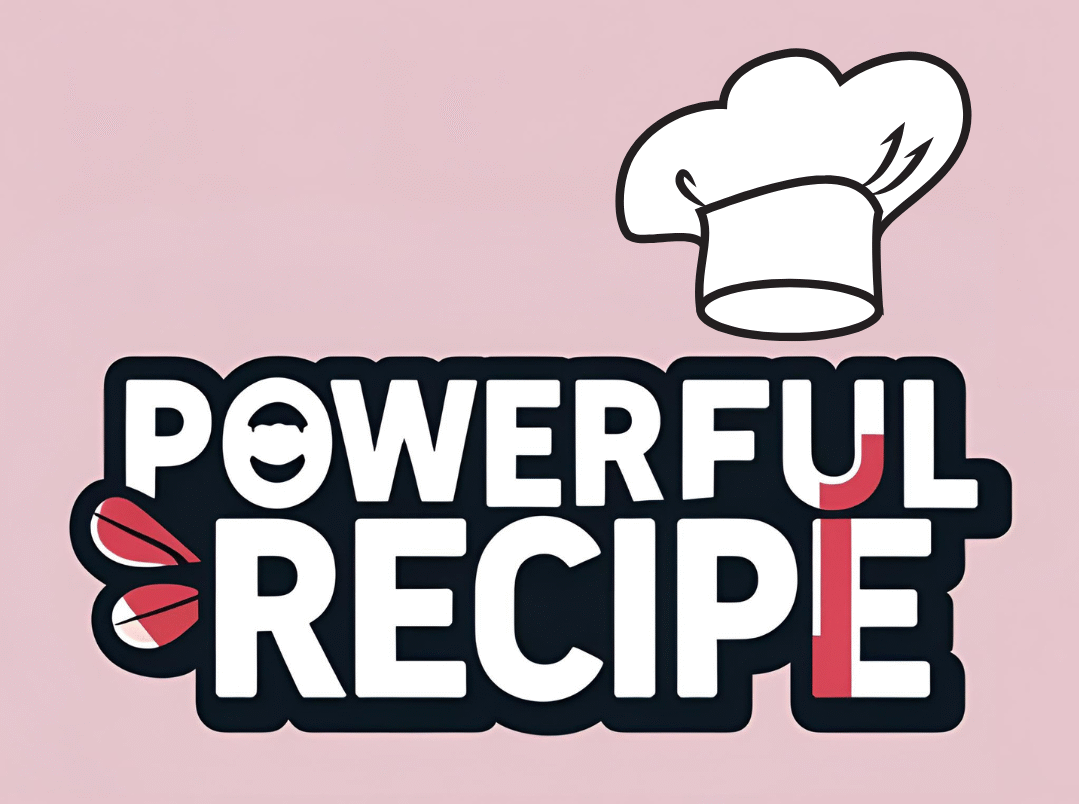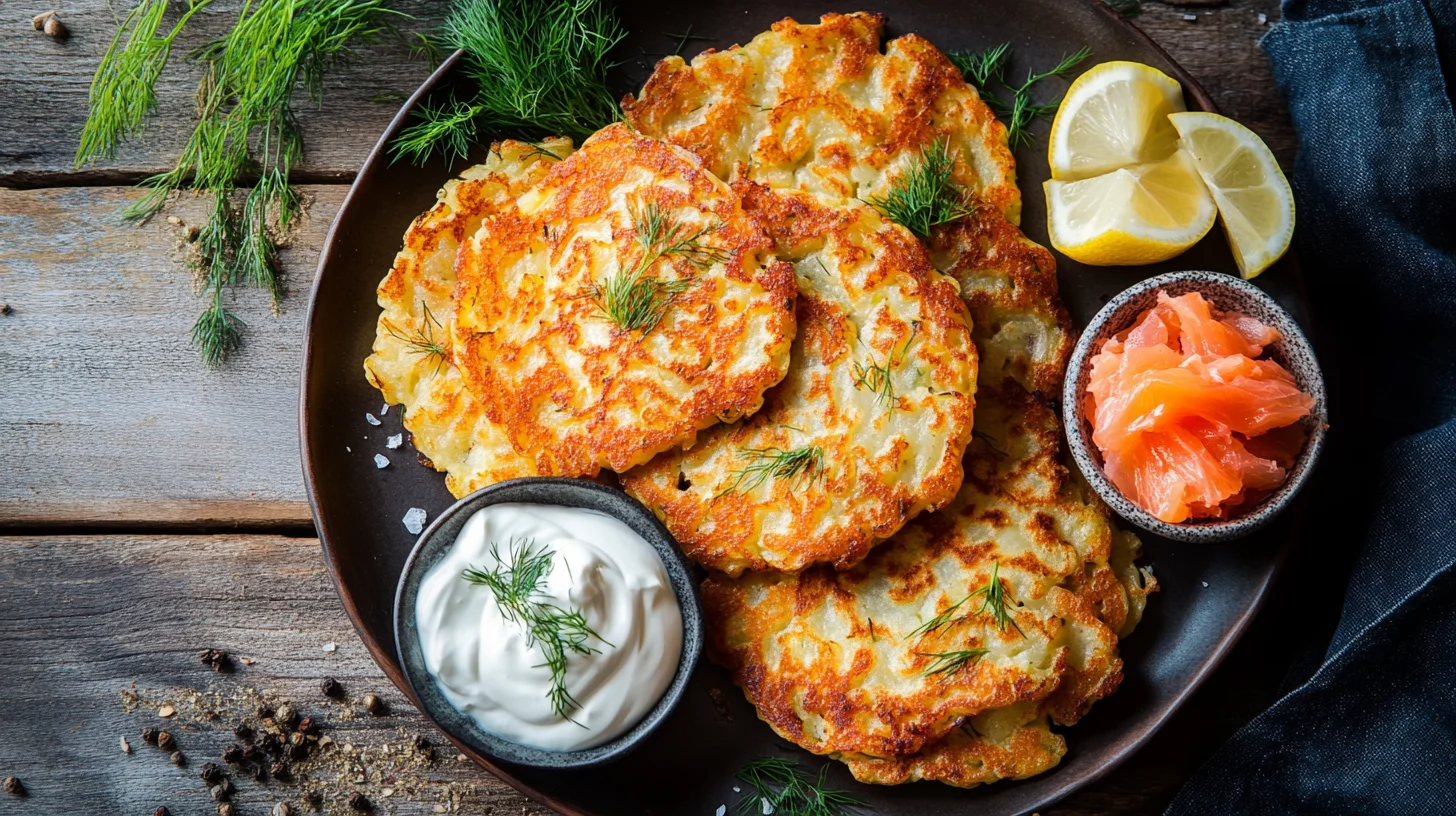Few dishes carry the heartwarming comfort of crispy, golden-brown German Potato Pancakes. Known in different parts of Germany as Reibekuchen or Kartoffelpuffer, these savory treats have stood the test of time, gracing family kitchens, street markets, and festive tables for centuries. Whether served with a dollop of applesauce, a side of sour cream, or as part of a full meal, they offer a perfect combination of texture and flavor that leaves you craving more.
At their core, German potato pancakes are made from grated potatoes, onions, eggs, and a few simple seasonings. But don’t let the simplicity fool you—there’s an art to making them just right. From the choice of potato to the oil used for frying, every detail plays a part in the final crispiness and taste. And while they are traditionally pan-fried, today you’ll also find baked and air-fried versions that retain the crunch with a lighter touch.
This comprehensive guide will take you through everything you need to know about German Potato Pancakes. We’ll explore their rich history, share a tried-and-true authentic recipe, dive into serving suggestions, regional variations, and even look at how these humble pancakes have made their way into kitchens around the world. You’ll also find plenty of practical tips, storage advice, and answers to common questions to ensure your pancakes turn out perfectly every time.
Whether you’re of German heritage, a food enthusiast seeking traditional European dishes, or simply someone who loves potatoes in every form—this guide is for you. By the end, you’ll not only know how to make German potato pancakes, but you’ll also appreciate the culture and tradition that surrounds them.
Let’s get grating!
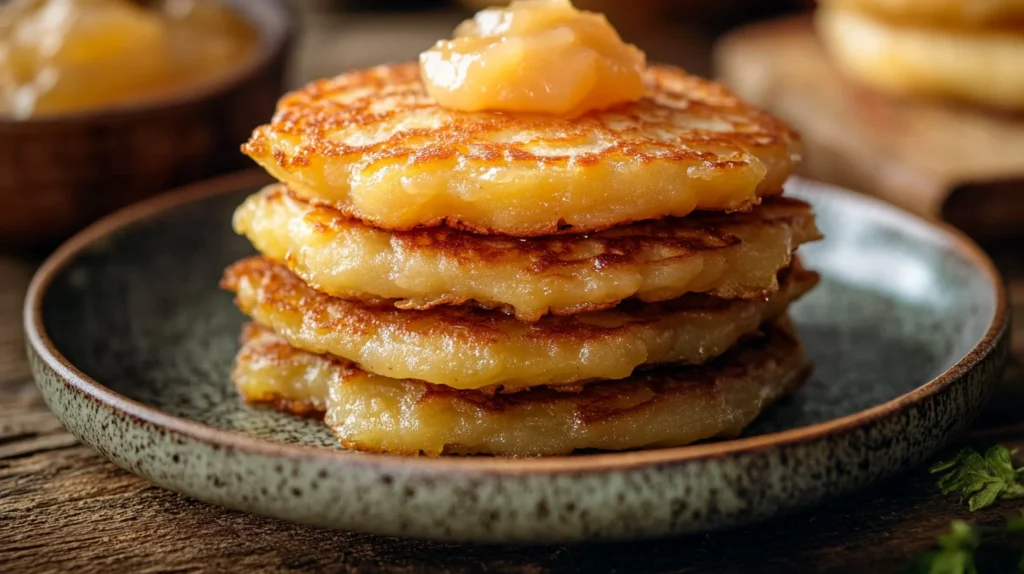
History and Origin of German Potato Pancakes
Traditional German Cuisine Overview
German Potato Pancakes cuisine is widely known for its hearty, comforting, and practical nature. Rooted in agricultural traditions and regional diversity, German food often revolves around meat, bread, cabbage, and—of course—potatoes. Introduced to Europe from South America in the 16th century, the potato quickly became a staple in German kitchens, especially among the working class. Its versatility, affordability, and ability to grow in cooler climates made it a vital ingredient in many classic dishes.
By the 18th century, potatoes were no longer considered exotic but rather a foundational food. Peasant communities used them to stretch meals and add substance to simple ingredients. Out of this practicality, the German potato pancake was born—a dish that combined grated potatoes with pantry staples to form a satisfying, crispy meal that could feed a family on a budget.
Evolution of Potato Pancakes in German Culture
The exact origin of Reibekuchen or Kartoffelpuffer is hard to pinpoint, as grated potato pancakes developed in multiple regions almost simultaneously due to the widespread availability of potatoes. The term Reibekuchen comes from the German verb reiben, meaning “to grate,” while Kartoffelpuffer combines Kartoffel (potato) and puffer (puff or fritter).
In rural households, families would prepare these pancakes using a simple hand grater and fry them in lard or sunflower oil over a wood-burning stove. They were especially popular during the colder months when fresh produce was scarce and families relied on root vegetables. The german potato pancakes were served as a main dish, often accompanied by applesauce, a sweet contrast to the salty, savory pancake.
By the 19th and 20th centuries, these german potato pancakes gained popularity beyond the home. Street vendors and food stalls began selling them fresh off the griddle at Christmas markets and fairs, turning them into a beloved German street food tradition that continues to this day. Visitors to cities like Cologne, Düsseldorf, and Munich can still find stalls frying up hot, crispy Reibekuchen to order.
Interestingly,german potato pancakes also hold cultural significance in Jewish cuisine, where they’re known as latkes and eaten during Hanukkah. While the ingredients are similar, the historical context and preparation techniques differ. Nonetheless, this crossover shows the shared love of potato-based comfort food across cultures.
From humble beginnings to holiday staple, German Potato Pancakes have woven themselves into the fabric of the country’s culinary identity. Their ability to adapt with time—through new ingredients, modern cooking techniques, and even health-conscious variations—has ensured their place in kitchens for generations to come.
Craving a dish that’s both crispy and elegant? You might also love these Cucumber Smoked Salmon Canapés—a perfect gourmet topping idea for mini potato pancakes!
Ingredients for Authentic German Potato Pancakes
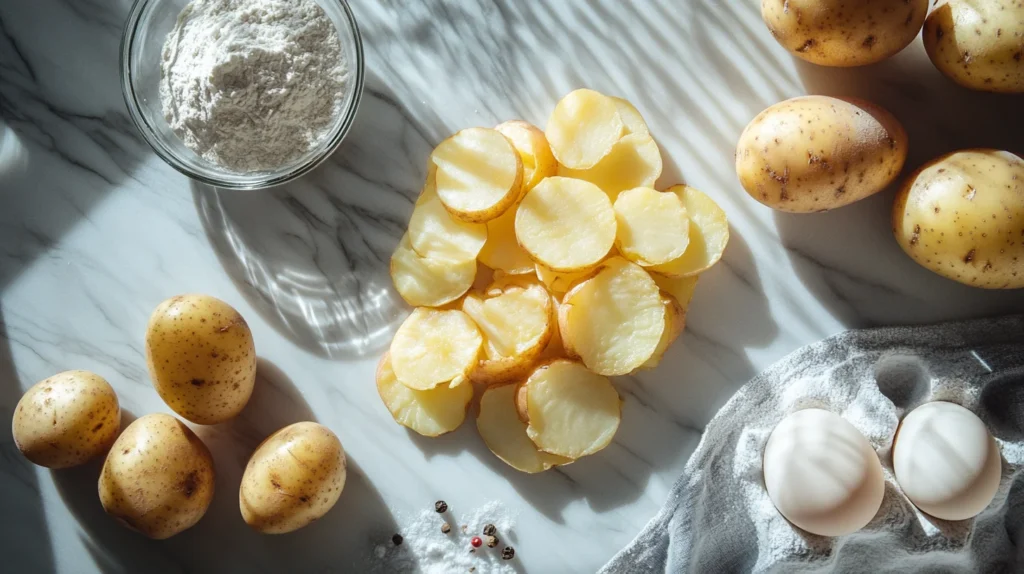
Core Ingredients: Potatoes, Onions, and More
At the heart of every authentic German Potato Pancake lies a short list of humble, readily available ingredients. While there are many modern variations, the traditional recipe typically calls for:
- Potatoes: The star of the dish. Ideally, use starchy potatoes like Russets or Maris Piper (in the UK) because they contain less water and help the pancakes get crispy without becoming mushy. In Germany, mehligkochende Kartoffeln (floury potatoes) are most commonly used.
- Onions: Finely grated or minced onions are added to the mixture for a subtle, aromatic flavor. Some people use white onions for sharpness, while others prefer sweeter yellow varieties.
- Eggs: These act as a binding agent to hold the grated potatoes and onions together during frying. One to two eggs are typically enough, depending on the batch size.
- Flour: A spoon or two of all-purpose flour helps thicken the batter and further bind the ingredients. In some cases, breadcrumbs are used as a substitute or complement for added texture.
- Salt & Pepper: These basic seasonings are crucial to bring out the earthy flavor of the potatoes.
- Oil or Fat for Frying: Traditional recipes often used lard or clarified butter (Butterschmalz), but vegetable oil or sunflower oil is now more common for health and convenience. The key is to use an oil with a high smoke point that lets the pancakes crisp up beautifully.
These ingredients come together to create that irresistible balance of a crispy outside and tender inside that German potato pancakes are famous for.
Optional Add-ins for Extra Flavor
While traditionalists may stick to the basics, there’s plenty of room to experiment with the flavor profile of your german potato pancakes. Here are some optional ingredients that can elevate your pancakes from classic to gourmet:
- Fresh herbs: Add chopped parsley, chives, or dill for freshness and color.
- Nutmeg: A small pinch can enhance the savory flavor with subtle warmth—very common in German home cooking.
- Garlic: Minced garlic or garlic powder can add depth for garlic lovers.
- Cheese: A small handful of grated cheese (like Emmental or Gouda) can make the interior rich and melty.
- Bacon or ham bits: Crispy bacon pieces mixed into the batter offer a smoky, savory twist.
These additions allow the base recipe to shine in new ways while still honoring the traditional roots of the dish.
Gluten-Free and Vegan Alternatives
German Potato Pancakes can easily be adapted to fit a variety of dietary preferences or restrictions without compromising on taste or texture.
For a gluten-free version:
- Replace regular flour with potato starch, cornstarch, or gluten-free all-purpose flour. These options help bind the batter without the need for gluten-based thickeners.
For a vegan version:
- Skip the eggs and use flaxseed meal or chia seeds mixed with water (1 tbsp seed + 2.5 tbsp water per egg) as a binding agent.
- Alternatively, mashed potatoes or plant-based egg substitutes can help hold the pancakes together.
For oil-conscious cooking:
- Use a non-stick skillet with minimal oil, or explore baking and air-frying options—methods we’ll cover later in the cooking and reheating sections.
Whether you stick to the original or give your pancakes a modern twist, the beauty of this dish lies in its flexibility and timeless flavor.
Looking for another comforting potato-based dish to try? Check out this cheesy breakfast favorite: Cheesy Potato Egg Scramble.
Step-by-Step Recipe: How to Make German Potato Pancakes
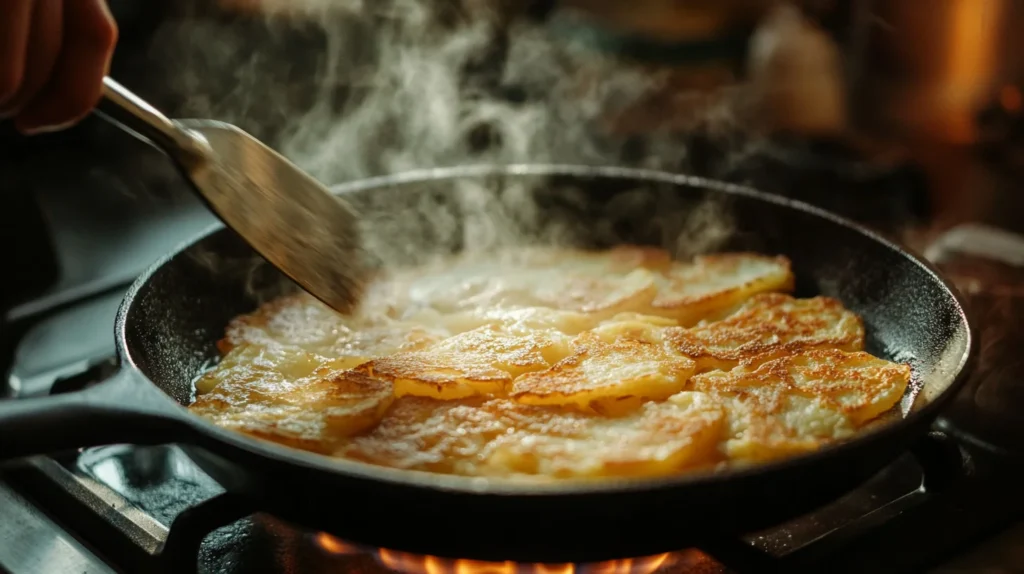
Preparation of Ingredients
The secret to a successful batch of German Potato Pancakes lies in the prep work. Here’s how to get started:
1. Choose the Right Potatoes:
As mentioned earlier, starchy potatoes like Russets (or mehligkochende Kartoffeln in Germany) are ideal. They have low moisture and high starch, giving your pancakes that essential crispness.
2. Wash, Peel, and Grate:
- Wash and peel 4 to 5 medium-sized potatoes.
- Grate them using the coarse side of a box grater or a food processor with a grating attachment. You want fine but not mushy shreds.
- Immediately place the grated potatoes in a bowl of cold water. This prevents browning and helps remove excess starch.
3. Drain and Squeeze:
After 5–10 minutes, drain the grated potatoes thoroughly and wrap them in a clean kitchen towel or cheesecloth. Twist and squeeze to remove as much moisture as possible. This step is critical—if your potatoes are too wet, the pancakes will be soggy.
4. Grate the Onion:
- Grate one small onion and mix it with the squeezed potato shreds. The onion not only adds flavor but also keeps the potatoes from oxidizing too quickly.
Mixing and Seasoning the Batter
Once your potatoes and onions are ready, it’s time to bring the batter together:
Ingredients for the batter:
- 4–5 medium potatoes (grated and drained)
- 1 small onion (grated)
- 2 eggs
- 2–3 tablespoons all-purpose flour (or gluten-free flour)
- Salt and pepper to taste (start with 1 tsp salt, ½ tsp pepper)
Optional Add-ins (mix in if desired):
- Chopped parsley or chives (1–2 tbsp)
- Pinch of nutmeg
- Garlic powder or minced garlic
- Grated cheese
Steps:
- Place the grated potatoes and onions into a large mixing bowl and stir to combine.
- Add the eggs and flour.
- Season with salt and pepper.
- Mix everything thoroughly using a spoon or your hands until the batter holds together without being watery.
If your mixture seems too wet, add a little more flour. If the mixture feels too dry, you can add a little milk or an additional egg to moisten and bind it better.
Frying Techniques for Perfect Crispiness
Now for the fun part—frying!
1. Preheat Your Pan:
Place a large skillet or frying pan over medium-high heat. Add enough oil to coat the bottom generously—about ¼ inch.Heat the oil until it’s hot and shimmering, but not smoking. You can test by dropping in a small piece of batter; it should sizzle immediately.
2. Shape the Pancakes:
Using a large spoon or your hands, scoop about 2 to 3 tablespoons of the potato mixture and flatten it into a round patty, about ¼-inch thick. Place it gently into the hot oil. Repeat, but don’t overcrowd the pan.
3. Fry Until Golden Brown:
Fry on each side for 3 to 4 minutes, or until the pancakes turn golden brown and crisp. Adjust the heat as needed so they don’t burn.
4. Drain and Rest:
Use a slotted spatula to remove the pancakes from the oil and place them on a paper towel-lined plate. This helps absorb excess oil and keeps them crisp.
5. Keep Warm (Optional):
If you’re cooking in batches, you can keep finished pancakes warm in a low oven (about 200°F / 90°C) on a wire rack over a baking sheet.
And just like that, you’ve made authentic German Potato Pancakes! They’re best enjoyed hot and fresh, but they also reheat well, which we’ll discuss later.
Tips for the Best German Potato Pancakes
Choosing the Right Type of Potatoes
Not all potatoes are created equal—especially when it comes to achieving that perfect pancake texture.
- Use starchy potatoes: These are essential for crispiness. In the U.S., go for Russet potatoes; in Europe, look for mehligkochende varieties like Agria or Bintje. Starchy potatoes have less moisture and bind better without needing too much flour.
- Avoid waxy potatoes like red or new potatoes. These are high in moisture and low in starch, which can make your pancakes soft and soggy instead of crisp.
If you only have waxy potatoes on hand, try mixing them with a little potato starch or cornstarch to help the texture.
Oil Selection and Frying Temperature
The choice of oil and how you handle it can make or break your German Potato pancakes.
- Best oil to use: High smoke point oils like sunflower oil, canola oil, grapeseed oil, or vegetable oil are excellent choices. They allow you to fry at high temperatures without burning the oil.
- Traditional fats: Germans traditionally used lard or Butterschmalz (clarified butter) for a richer flavor. If you’re going for authenticity and aren’t worried about calories, these are excellent.
- Ideal frying temperature: Keep the oil between 350°F–375°F (175°C–190°C). Too cold, and the pancakes will absorb oil and turn greasy. Too hot, and they’ll burn before the inside cooks.
Tip: Test the oil with a small piece of batter—if it sizzles and bubbles immediately, it’s ready.
Keeping Pancakes Crispy After Cooking
You’ve made a batch of beautifully fried German Potato Pancakes—now how do you keep them crispy until serving time?
- Drain well: Always place fried pancakes on paper towels or a wire rack to drain excess oil immediately after frying. Avoid stacking them, as this traps steam and softens the crust.
- Keep warm without steaming: If you’re cooking a large batch, place the finished pancakes on a wire rack set over a baking sheet and keep them in the oven at 200°F (90°C). This keeps them warm and crisp.
- Serve fresh: Like French fries, German potato pancakes are best enjoyed right after cooking. The longer they sit, the more likely they are to lose their crunch.
- Reheating tip: If you must reheat, do so in a toaster oven, air fryer, or frying pan rather than the microwave, which makes them soggy.
Troubleshooting Common Mistakes
Even experienced cooks can run into hiccups. Here’s how to fix the most common issues:
- Too soggy or falling apart:
- You didn’t squeeze out enough moisture. Use a towel to press out every drop from the grated potatoes.
- Add more flour or another egg to improve binding.
- Not crispy enough:
- The oil might be too cold. Increase the heat slightly.
- Or the potatoes had too much moisture—squeeze harder next time.
- Burning before cooking through:
- The oil is too hot. Reduce the heat and cook a bit longer on medium for even doneness.
- Greasy pancakes:
- The batter might be absorbing too much oil due to cold oil or overcrowding the pan.
- Fry in small batches and maintain proper oil temperature.
Master these tips and you’ll be serving up restaurant-quality Reibekuchen every time—with a crunch your guests won’t forget!
Serving Suggestions and Pairings
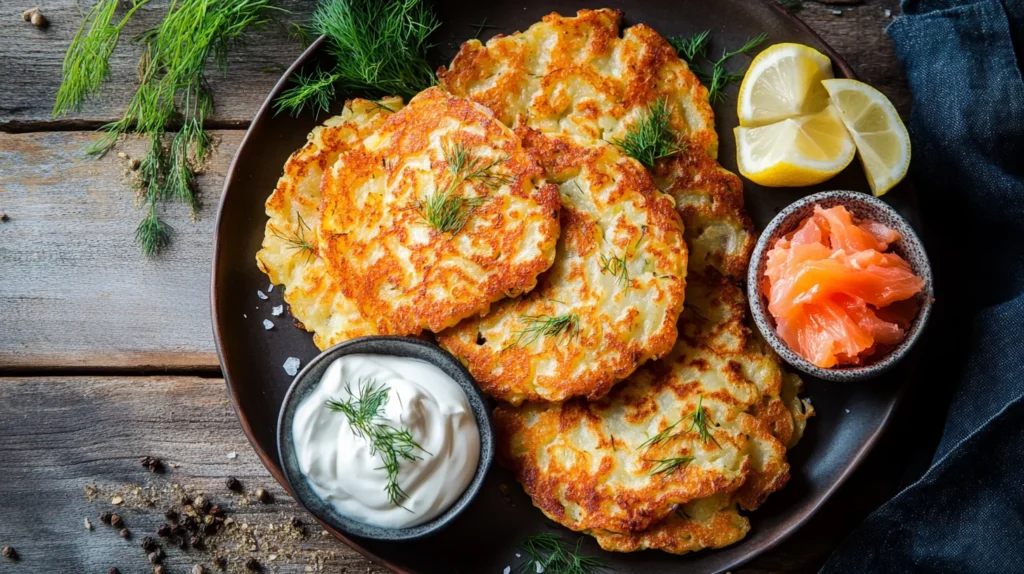
Popular Toppings: Applesauce, Sour Cream, and More
The beauty of German Potato Pancakes lies not just in their crisp texture, but also in how versatile they are when it comes to toppings. Here are some of the most beloved ways to serve them:
- Applesauce (Apfelmus): A classic pairing in Germany, the sweetness of applesauce complements the salty, crispy pancakes perfectly. It’s especially common at Christmas markets and family dinners.
- Sour Cream or Quark: For a creamy and tangy contrast, serve with a generous dollop of sour cream or Quark (a soft German cheese similar to Greek yogurt).
- Smoked Salmon and Dill: For a gourmet twist, top your pancakes with smoked salmon, a bit of horseradish or cream cheese, and fresh dill.
- Fried Eggs or Bacon: Turn your pancakes into a hearty breakfast by adding fried eggs, crispy bacon, or even sausage on the side.
- Cheese and Chives: A sprinkle of shredded cheese and chopped fresh chives gives a melty, savory finish.
Side Dishes That Complement Reibekuchen
If you’re serving Kartoffelpuffer as part of a full meal, consider these side dishes:
- Cucumber Salad (Gurkensalat): Light and refreshing, this balances the richness of the pancakes.
- German Sauerkraut: Adds a punchy, fermented flavor that cuts through the oil.
- Warm Red Cabbage: Slightly sweet and tangy, this pairs wonderfully in fall and winter.
Serving Ideas for Breakfast, Lunch, and Dinner
Breakfast: Serve with fried eggs, applesauce, and coffee for a hearty German-style breakfast.
Lunch: Add a green salad or cucumber salad, and serve with sour cream or herbed yogurt dip.
Dinner: Pair with grilled bratwurst, sauerkraut, or even a creamy mushroom sauce.
They also make a great snack or appetizer—especially when made small and served with a variety of dips.
Regional Variations Across Germany
Reibekuchen vs. Kartoffelpuffer: Is There a Difference?
In practice, Reibekuchen and Kartoffelpuffer are used interchangeably, but some regions in Germany claim subtle differences:
- Reibekuchen: More common in the Rhineland, these are often thinner, crispier, and served with applesauce.
- Kartoffelpuffer: A term more commonly used in southern Germany, where the pancakes may be slightly thicker or served as part of a main course.
Both terms refer to the same basic dish—grated potato pancakes fried until golden.
Rhineland Style vs. Bavarian Style
- Rhineland Style: Often served at Christmas markets with sweet toppings like apple compote or sugar.
- Bavarian Style: Served with hearty meats or even topped with gravy or sauerkraut.
Each region brings its own twist, reflecting the diversity and adaptability of this beloved dish.
German Potato Pancakes Around the World
Similar Dishes in Eastern Europe and the US
The concept of a grated germen potato pancakes isn’t unique to Germany. Here are some global cousins:
- Latkes (Jewish cuisine): Popular during Hanukkah, often made with matzo meal and served with sour cream or applesauce.
- Draniki (Belarus/Ukraine): Similar to Reibekuchen but often include garlic and herbs.
- Hash Browns (USA): Loosely related, hash browns are made from shredded potatoes, though they are often cooked looser and less structured.
How Immigrants Spread the Tradition Globally
German potato pancakes immigrants brought their recipes with them across Europe and North America. Over time, local ingredients and preferences shaped new variations, but the core technique—grating, seasoning, and frying—remains unchanged.
Today, you’ll find versions of German Potato Pancakes on diner menus in the U.S., holiday tables in Poland, and brunch spreads in Austria, showing how one humble recipe can travel and adapt while still holding onto its roots.
Storage and Reheating Tips
How to Store Leftovers Properly
If you’ve made more pancakes than you can eat in one sitting, no worries—they store quite well.
- Refrigerator: Place cooled pancakes in an airtight container. Layer them between parchment or paper towels to prevent sticking. They can be stored in the refrigerator for up to three days.
- Freezer: For longer storage, freeze pancakes in a single layer on a baking sheet. Once frozen, transfer to a freezer bag. They’ll keep well for up to 2 months.
Best Methods to Reheat Without Losing Texture
- Toaster Oven or Oven: Preheat to 375°F (190°C) and bake for 8–10 minutes. This keeps them crisp.
- Skillet: Reheat in a dry non-stick pan over medium heat for 2–3 minutes per side.
- Air Fryer: Perfect for reviving crispiness. Heat at 350°F (175°C) for 5 minutes.
Avoid the microwave if possible—it will make them soft and rubbery.
Frequently Asked Questions
What is the difference between latkes and German potato pancakes?
Latkes and German potato pancakes are very similar, but they come from different cultural backgrounds and have some slight differences in preparation.
Latkes are traditional in Jewish cuisine, especially during Hanukkah. They often include matzo meal or breadcrumbs as a binder and are usually flavored with onion and sometimes garlic.
German potato pancakes (Reibekuchen or Kartoffelpuffer) typically use flour and egg as binders and may be served with sweet toppings like applesauce.
While both are made with grated potatoes and fried until crispy, the texture and seasoning can vary depending on regional and cultural preferences.
What are potato pancakes called in German?
In German, potato pancakes are most commonly called Reibekuchen or Kartoffelpuffer.
Reibekuchen comes from the word reiben (to grate) and is more commonly used in the Rhineland region.
Kartoffelpuffer combines Kartoffel (potato) and Puffer (fritter or puff), and is more popular in southern and central Germany.
Both terms refer to the same dish: crispy, pan-fried potato pancakes made from grated raw potatoes.
What is the German version of latkes?
The German version of latkes is known as Reibekuchen or Kartoffelpuffer.
These are traditional German potato pancakes made from grated raw potatoes, onion, egg, and flour, and then fried until golden brown. While latkes are rooted in Jewish culinary tradition, German versions are a staple in street food culture, especially during fairs and Christmas markets.
They’re often served with applesauce or sour cream and can be enjoyed sweet or savory.
How do you say potato pancake in German?
The term potato pancake in German can be translated as:
Reibekuchen – Common in western Germany, especially the Rhineland.
Kartoffelpuffer – Widely used in central and southern regions of Germany.
Erdäpfelpuffer – An Austrian or Bavarian variant, using Erdapfel (another word for potato).
All these terms refer to the same beloved dish: a crisp, savory pancake made from grated potatoes and onions.
Conclusion
From the bustling streets of Cologne’s Christmas markets to cozy kitchens in Bavaria, German Potato Pancakes—whether you call them Reibekuchen or Kartoffelpuffer—hold a special place in German culinary heritage. With their golden, crispy exterior and soft, savory interior, these humble pancakes prove that simple ingredients can create extraordinary results when treated with care and tradition.
As we’ve explored, these pancakes are more than just a delicious recipe—they’re a window into history, regional culture, and even global food connections. Whether you’re making them for a festive occasion, a family meal, or just a comforting snack, the process of grating, frying, and serving brings with it a sense of nostalgia and community.
The beauty of German Potato Pancakes lies in their versatility. You can enjoy them sweet with applesauce, savory with sour cream and herbs, or dressed up with gourmet toppings like smoked salmon. And with easy adaptations for gluten-free, vegan, or low-oil versions, this recipe welcomes everyone to the table.
Now that you’re equipped with a complete guide—from history and variations to step-by-step instructions and serving ideas—it’s time to bring this comforting classic into your own kitchen. Embrace the crackle of the frying pan, the aroma of golden potatoes, and the joy of sharing homemade goodness with others.
Happy cooking, and Guten Appetit!
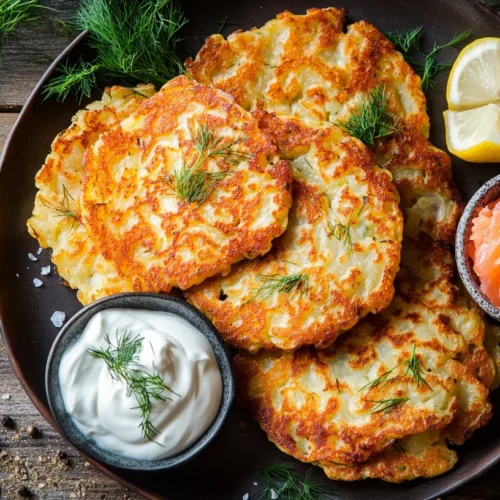
Authentic German Potato Pancakes (Crispy Reibekuchen)
Equipment
- Box grater or food processor
- Large bowl
- Clean kitchen towel or cheesecloth
- Skillet or frying pan
- Spatula
- Paper towels or wire rack
- Measuring cups and spoons
Ingredients
- 4 medium starchy potatoes like Russet or Maris Piper, peeled and grated
- 1 small onion finely grated
- 2 large eggs
- 2 –3 tablespoons all-purpose flour or gluten-free flour
- 1 teaspoon salt
- ½ teaspoon black pepper
- Oil for frying sunflower, canola, or vegetable oil
- Optional Add-ins:
- 1 –2 tablespoons chopped fresh parsley or chives
- A pinch of nutmeg
- 1 clove garlic minced
- ¼ cup grated cheese e.g., Emmental or Gouda
Instructions
- Grate and soak the potatoes in cold water for 5–10 minutes to remove excess starch.
- Drain and squeeze the potatoes dry using a clean towel or cheesecloth.
- In a large bowl, mix the grated potatoes with the grated onion, eggs, flour, salt, and pepper. Add any optional ingredients if desired.
- Heat oil in a skillet over medium-high heat. Test with a small bit of batter—it should sizzle.
- Spoon 2–3 tablespoons of batter into the pan and flatten into a patty. Fry 3–4 minutes per side until golden brown.
- Remove and drain on paper towels or a wire rack.
- Serve hot with applesauce, sour cream, or your favorite toppings.
